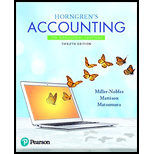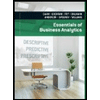
Horngren's Accounting (12th Edition)
12th Edition
ISBN: 9780134486444
Author: Tracie L. Miller-Nobles, Brenda L. Mattison, Ella Mae Matsumura
Publisher: PEARSON
expand_more
expand_more
format_list_bulleted
Concept explainers
Textbook Question
Chapter 21, Problem 7QC
If a company increases its sales price per unit for Product A, the new breakeven point will
Learning Objective 4
a. increase.
b. decrease.
c. remain the same.
d. More information is needed.
Expert Solution & Answer
Want to see the full answer?
Check out a sample textbook solution
Students have asked these similar questions
Building from the Module 2 Critical Thinking assignment about your company’s water purification product and Nigerian market, research the components needed to build the product.
Use the following questions to guide your decisions about production and components, respond to the following topics for this week’s critical thinking assignment.
What does nigeria produce and export?
What does nigeria import; what are the imports used for?
To what degree does nigeria have relevant and cost-effective component manufacturing capabilities?
Does nigeria have relevant and cost-effective manufacturing/assembly capabilities to create products of acceptable quality?
If nigeria does not have relevant component and manufacturing skills, where will the water purification components/devices be sourced from given the target country’s trade agreements?
How do trade profiles and trade relationships enter into your decision about manufacturing locations?
Include relevant theories and concepts related…
Find five credible external sources to support the ideas on the below paper and write the annotation should have two parts: a summary of the source’s main idea and conclusions, then a discussion of how you are going to use it in your Portfolio Milestone. Make sure to Create an APA7-formatted reference citation for each source.
The theory in question is the Intercultural Communication Theory. This theory, according to credible sources such as the International Journal of Business Communication, is a framework for understanding and managing communication between people from different cultural backgrounds. It originated from the need to facilitate better communication and understanding in diverse settings, and has evolved to its current status as a critical tool in various fields, including business, medicine, and education.
In the field of business, the Intercultural Communication Theory can help individuals better work in intercultural settings by enhancing their…
Want to this question answer general accounting
Chapter 21 Solutions
Horngren's Accounting (12th Edition)
Ch. 21 - For Frank’s Funky Sounds, straight-line...Ch. 21 - Prob. 2QCCh. 21 - Prob. 3QCCh. 21 - Prob. 4QCCh. 21 - Prob. 5QCCh. 21 - On a CVP graph, the total cost line intersects the...Ch. 21 - If a company increases its sales price per unit...Ch. 21 - Prob. 8QCCh. 21 - Prob. 9QCCh. 21 - Prob. 10QC
Ch. 21 - Donovan Company incurred the following costs while...Ch. 21 - Prob. 12AQCCh. 21 - Prob. 1RQCh. 21 - Prob. 2RQCh. 21 - What is a mixed cost? Give an example.Ch. 21 - What is the purpose of using the high-low method?Ch. 21 - Describe the three steps of the high-low method.Ch. 21 - What is the relevant range?Ch. 21 - A chain of convenience stores has one manager per...Ch. 21 - A chain of convenience stores has one manager per...Ch. 21 - Prob. 9RQCh. 21 - Prob. 10RQCh. 21 - Prob. 11RQCh. 21 - What is cost-volume-profit analysis?Ch. 21 - Prob. 13RQCh. 21 - Prob. 14RQCh. 21 - Prob. 15RQCh. 21 - Of the three approaches to calculate sales...Ch. 21 - Prob. 17RQCh. 21 - Prob. 18RQCh. 21 - On the CVP graph, where is the breakeven point...Ch. 21 - What is sensitivity analysis? How do managers use...Ch. 21 - Prob. 21RQCh. 21 - What is cost stickiness? Why do managers need to...Ch. 21 - Prob. 23RQCh. 21 - What is a company's cost structure? How can cost...Ch. 21 - What is operating leverage? What does it mean if a...Ch. 21 - Prob. 26RQCh. 21 - What is absorption costing?Ch. 21 - What is variable costing?Ch. 21 - How are absorption costing and variable costing...Ch. 21 - When units produced equal units sold, how does...Ch. 21 - Prob. 31ARQCh. 21 - Prob. 32ARQCh. 21 - Identifying variable, fixed, and mixed costs...Ch. 21 - Prob. S21.2SECh. 21 - Using the high-low method Learning Objective 1...Ch. 21 - Prob. S21.4SECh. 21 - Prob. S21.5SECh. 21 - Prob. S21.6SECh. 21 - Prob. S21.7SECh. 21 - Computing contribution margin, units and required...Ch. 21 - Prob. S21.9SECh. 21 - Prob. S21.10SECh. 21 - Prob. S21.11SECh. 21 - Use the following information to complete Short...Ch. 21 - Use the following information to complete Short...Ch. 21 - Prob. S21.14SECh. 21 - Prob. S21.15SECh. 21 - Prob. S21.16SECh. 21 - Prob. S21.17SECh. 21 - S21A-18 Classifying costs
Learning Objective 6...Ch. 21 - Use the following information for Short Exercises...Ch. 21 - Prob. S21A.20SECh. 21 - Prob. S21A.21SECh. 21 - Prob. S21A.22SECh. 21 - Prob. S21A.23SECh. 21 - Prob. S21A.24SECh. 21 - Prob. S21A.25SECh. 21 - Prob. S21A.26SECh. 21 - Prob. E21.27ECh. 21 - Prob. E21.28ECh. 21 - Prob. E21.29ECh. 21 - Prob. E21.30ECh. 21 - Prob. E21.31ECh. 21 - Prob. E21.32ECh. 21 - Prob. E21.33ECh. 21 - Prob. E21.34ECh. 21 - Prob. E21.35ECh. 21 - Prob. E21.36ECh. 21 - Prob. E21.37ECh. 21 - Prob. E21.38ECh. 21 - Prob. E21.39ECh. 21 - Prob. E21.40ECh. 21 - Prob. E21.41ECh. 21 - Prob. E21.42ECh. 21 - Prob. E21.43ECh. 21 - Prob. E21.44ECh. 21 - Prob. E21.45ECh. 21 - Prob. E21A.46ECh. 21 - Prob. E21A.47ECh. 21 - Prob. E21A.48ECh. 21 - Prob. E21A.49ECh. 21 - Prob. E21A.50ECh. 21 - Prob. E21A.51ECh. 21 - Prob. E21A.52ECh. 21 - Prob. E21A.53ECh. 21 - Prob. P21.54APGACh. 21 - Prob. P21.55APGACh. 21 - Analyzing CVP relationships Learning Objectives...Ch. 21 - Prob. P21.57APGACh. 21 - Prob. P21.58APGACh. 21 - Prob. P21A.59APGACh. 21 - Prob. P21A.60APGACh. 21 - Prob. P21.61BPGBCh. 21 - Prob. P21.62BPGBCh. 21 - Prob. P21.63BPGBCh. 21 - Prob. P21.64BPGBCh. 21 - Prob. P21.65BPGBCh. 21 - Prob. P21A.66BPGBCh. 21 - Prob. P21A.67BPGBCh. 21 - Using Excel for cost-volume-profit(CVP) analysis...Ch. 21 - Prob. P21.69CPCh. 21 - Comprehensive Problem for Chapters 18- 21 The...Ch. 21 - Comprehensive Problem for Chapters 18- 21 The...Ch. 21 - Comprehensive Problem for Chapters 18- 21 The...Ch. 21 - Comprehensive Problem for Chapters 18- 21 The...Ch. 21 - Comprehensive Problem for Chapters 18- 21 The...Ch. 21 - Prob. 6CPCh. 21 - Prob. 21.1TIATCCh. 21 - Prob. 21.1DCCh. 21 - Prob. 21.1EI
Knowledge Booster
Learn more about
Need a deep-dive on the concept behind this application? Look no further. Learn more about this topic, accounting and related others by exploring similar questions and additional content below.Similar questions
- Cool Comfort currently sells 360 Class A spas, 520 Class C spas, and 230 deluxe model spas each year. The firm is considering adding a mid-class spa and expects that, if it does, it can sell 375 of them. However, if the new spa is added, Class A sales are expected to decline to 255 units while Class C sales are expected to decline to 240. The sales of the deluxe model will not be affected. Class A spas sell for an average of $13,500 each. Class C spas are priced at $7,200 and the deluxe model sells for $19,000 each. The new mid-range spa will sell for $11,000. What is the value of erosion? General Accountingarrow_forwardStep by step solutionarrow_forwardAnswer? ? General accounting questionarrow_forward
- Stock acquisition is 950000,book value of acquired company is 700000arrow_forwardThe following information is available for Betty DeRose, Inc.: Accounts payable Inventory January 1, 2012 December 31, 2012 $70,000 $55,000 $88,000 $79,000 Betty DeRose reported $145,000 of cash paid to suppliers for purchases of inventory in its 2012 cash flow statement. Calculate Betty's cost of goods sold for 2012.arrow_forwardRock Corporation sells its product for $16 per unit. Next year, fixed expenses are expected to be $454,000 and variable expenses are expected to be $9 per unit. How many units must the company sell to generate a net operating income of $92,000?arrow_forward
- Cool Comfort currently sells 360 Class A spas, 520 Class C spas, and 230 deluxe model spas each year. The firm is considering adding a mid-class spa and expects that, if it does, it can sell 375 of them. However, if the new spa is added, Class A sales are expected to decline to 255 units while Class C sales are expected to decline to 240. The sales of the deluxe model will not be affected. Class A spas sell for an average of $13,500 each. Class C spas are priced at $7,200 and the deluxe model sells for $19,000 each. The new mid-range spa will sell for $11,000. What is the value of erosion? Answerarrow_forwardWaiting for your solutionarrow_forwardRock Corporation sells its product for $16 per unit. Next year, fixed expenses are expected to be $454,000 and variable expenses are expected to be $9 per unit. How many units must the company sell to generate a net operating income of $92,000? Questionarrow_forward
- Cool Comfort currently sells 360 Class A spas, 520 Class C spas, and 230 deluxe model spas each year. The firm is considering adding a mid-class spa and expects that, if it does, it can sell 375 of them. However, if the new spa is added, Class A sales are expected to decline to 255 units while Class C sales are expected to decline to 240. The sales of the deluxe model will not be affected. Class A spas sell for an average of $13,500 each. Class C spas are priced at $7,200 and the deluxe model sells for $19,000 each. The new mid-range spa will sell for $11,000. What is the value of erosion? Helparrow_forwardCool Comfort currently sells 360 Class A spas, 520 Class C spas, and 230 deluxe model spas each year. The firm is considering adding a mid-class spa and expects that, if it does, it can sell 375 of them. However, if the new spa is added, Class A sales are expected to decline to 255 units while Class C sales are expected to decline to 240. The sales of the deluxe model will not be affected. Class A spas sell for an average of $13,500 each. Class C spas are priced at $7,200 and the deluxe model sells for $19,000 each. The new mid-range spa will sell for $11,000. What is the value of erosion?arrow_forwardGeneral accountingarrow_forward
arrow_back_ios
SEE MORE QUESTIONS
arrow_forward_ios
Recommended textbooks for you
 Cornerstones of Cost Management (Cornerstones Ser...AccountingISBN:9781305970663Author:Don R. Hansen, Maryanne M. MowenPublisher:Cengage LearningPrinciples of Accounting Volume 2AccountingISBN:9781947172609Author:OpenStaxPublisher:OpenStax College
Cornerstones of Cost Management (Cornerstones Ser...AccountingISBN:9781305970663Author:Don R. Hansen, Maryanne M. MowenPublisher:Cengage LearningPrinciples of Accounting Volume 2AccountingISBN:9781947172609Author:OpenStaxPublisher:OpenStax College Essentials Of Business AnalyticsStatisticsISBN:9781285187273Author:Camm, Jeff.Publisher:Cengage Learning,
Essentials Of Business AnalyticsStatisticsISBN:9781285187273Author:Camm, Jeff.Publisher:Cengage Learning,

Cornerstones of Cost Management (Cornerstones Ser...
Accounting
ISBN:9781305970663
Author:Don R. Hansen, Maryanne M. Mowen
Publisher:Cengage Learning

Principles of Accounting Volume 2
Accounting
ISBN:9781947172609
Author:OpenStax
Publisher:OpenStax College

Essentials Of Business Analytics
Statistics
ISBN:9781285187273
Author:Camm, Jeff.
Publisher:Cengage Learning,
Financial Risks - Part 1; Author: KnowledgEquity - Support for CPA;https://www.youtube.com/watch?v=mFjSYlBS-VE;License: Standard youtube license